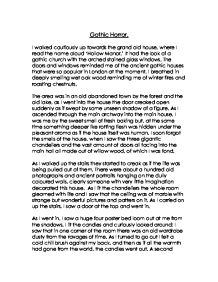

Dreamers make do with what can be salvaged from the wreckage, and “salvagepunk” (a term coined by Evan Calder Williams for the aesthetic of George Miller’s Mad Max films) is most definitely a favored tendency in the collection.
GOTHIC LITERATURE ESSAY SERIES
The essay by Fábio Fernandes on Kim Stanley Robinson’s novel New York 2140 (2017) suggests it is a “breakthrough” work in the author’s writing career because it aims for a “logistic utopia” after the sea level rises and sinks Manhattan, a political pragmatics that leaves behind large-scale revolutionary visions for temporary communities and improvised solutions that offer the promise of “stepwise reform.” The SF valued here lives with modest hopes for temporary collectivities and moments of community, after a 20th century that so resolutely screwed up utopian blueprints that it needed to invent the word “dystopia.” The first 20 years of the new millennium have been only a series of red lights ignored by the juggernaut of disaster capitalism, unchecked global development, and biopolitical control of populations, so perhaps it is apt to think in these entirely qualified and modest ways.

In turn, the collection is divided into four roughly equal sections, some with more coherence than others: 1) “Emergence,” 2) “Rupture,” 3) “Transformation,” and 4) “Revolution.” This might suggest a trajectory towards texts that envision overthrow or radical change, but perhaps as a symptom of the times, the emphasis tends to be on small flickers of hope, the temporary or fugitive communities that come together in the margins, or the always thoroughly compromised utopias that might flower only on the page or screen. This gives each chapter its slightly awkward titling: the name of the text, and its active or activist possibility (“Affective Praxis,” “Deimperializing Empire,” “Inhabiting Hostile Futures,” “Black Lives Matter SF,” and so on). The task the editors gave their contributors was to “choose an SF text you love and explore how it helps us think of ways to live in, survive, and grow beyond the inequalities and injustices of our times.” They want to convey that the genre across its now myriad forms has the potential to be a kind of toolkit not just for imagining utopian alternatives but also for implementing them, however incompletely and precariously, in the fissures of the dystopian now. This emphasis on action might be a harbinger of one possible future of this kind of cultural study, a future shown emerging-suitably unevenly amid the wide diversity of these essays-out of the multiple crises of the present. No wonder so many of them dream of action: SF as an active doing, a form of activism, rather than as a passive body of texts consumed in quarantined isolation, behind shuttered doors, away from the emptied-out public sphere. Many of the roughly 40 essayists (including the book’s editors Ida Yoshinaga, Sean Guynes, and Gerry Canavan) refer to the lockdown conditions in which they wrote their contributions through the first year of the COVID-19 pandemic. UNEVEN FUTURES: Strategies for Community Survival from Speculative Fiction (2022), a large-scale communal project of a book, is a fascinating snapshot of what the science fiction community has become in the 2020s-as a multimedia genre, an area of academic study, a set of tropes to be made and remade by makers, or a form of political praxis.


 0 kommentar(er)
0 kommentar(er)
